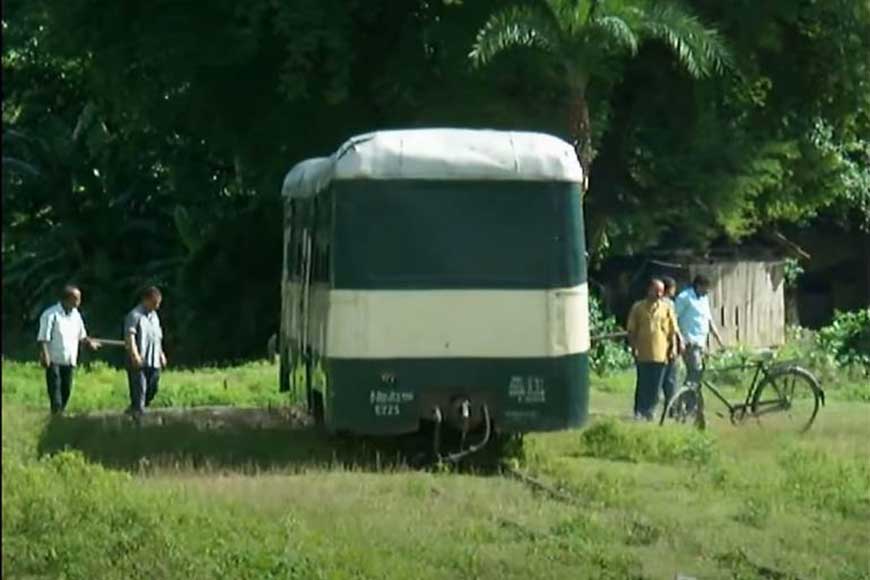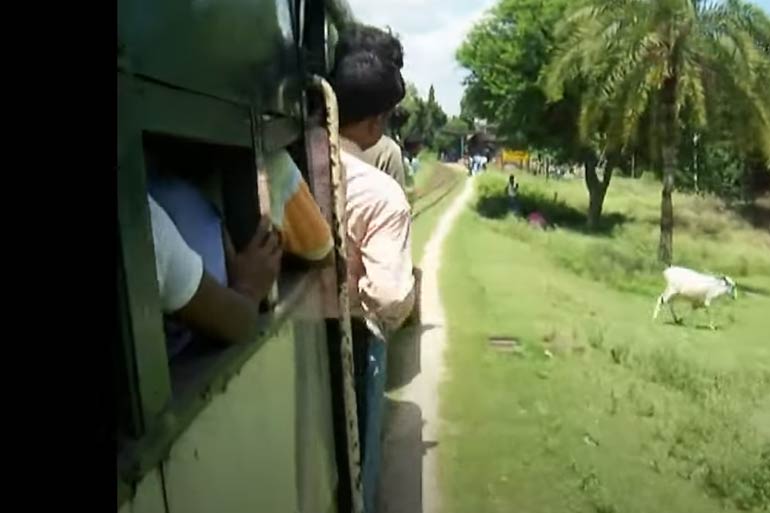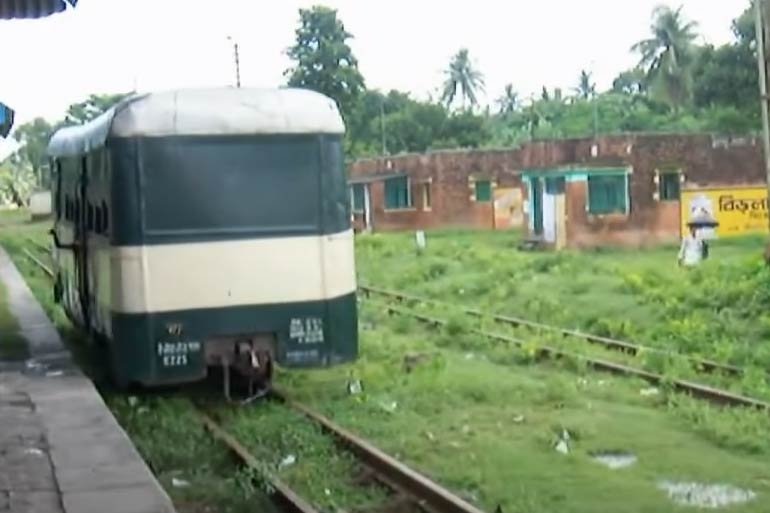The Santipur Local

Indian Railways -- one of the world’s largest railway systems that run over 12,500 trains every day -- is more than just the country's transport lifeline. For the 23 million passengers who use it daily, it is almost a way of life -- with a unique charm and special rhythm of its own.The Indian Railways is, to borrow a popular tourism advertisement phrase, a mode that beckons travelers to see the heart of India (Hindustan Ka Dil Dekho).
Trains are like the veins of this country, they are a platform to enter people's lives. Every passenger is a story. They come from so many different walks of life. Railways give you a wholesome experience, not only in terms of languages and ethnicities but also food and so much more. Local trains or suburban trains are the lifelines for Mumbai and Kolkata for people who come to the city from other districts. Prior to the nation-wide lockdown announced in March, none of us could imagine that these train services would be stopped totally for months. But a microscopic organism, a potent virus did just that!
Martin’s Light Railways (MLR) was part of Martin & Company of Calcutta responsible for the railway operations. MLR operated several disparate Narrow Gauge (NG) light railways in the Gangetic plain, from Calcutta in the east to Delhi in the west.
Before the pandemic, Kolkata Suburban Railway that serves the Kolkata metropolitan area and its surroundings,operated more than 1500 services, carrying 3,500,000 people daily.It was only eight months ago when the railway platforms, like citadels, remained active and alert 24X7, rife with thousands of footfalls from the crack of dawn till well past midnight. Every morning, a sea of people jostled at stations to catch the trains to rush to their workplace on time. The over-crowded nine or 12-bogey compartments would be crammed with passengers and each train would carry in itsheart, millions of tales of love and betrayal, hope and sorrow, victories and defeats, some expressed but most remained unspoken, unrequited. Hawkers would inch their way inside the packed compartments and conceived ingenious methods to attract the attention of unassuming passengers and convert them into loyal buyers. Beggars would seek alms in the most innovative ways. And the train would move on to its destination, rhythmically, unaffected by the distractions.

But life in the suburban trains came to a sudden standstill following the lockdown. The colourful vignettes of life were erased from the canvas as it were, leaving it bereft of any colour and life. I felt nostalgic as this lockdown phase took me back to a time when tiny three-compartment trains plied on the narrow-gauge railroad tracks. Martin’s Light Railways (MLR) was part of Martin & Company of Calcutta responsible for the railway operations. MLR operated several disparate Narrow Gauge (NG) light railways in the Gangetic plain, from Calcutta in the east to Delhi in the west. In the late 18th century, MLR began operations and trains plied on narrow gauge tracks in different parts of undivided Bengal including Shyambazar in north Kolkata, Kalighat-Falta in the southern fringe of the city, Howrah-Amta, Jessore-Jhinaidaha, AhmedpurKatowa andShantipur-Krishnagar-Nabadweep Ghat.
Kalighat–Falta Railway connecting Gholeshapur in Behala to Falta was opened on 28 May 1917 and was extended a further 0.92 miles (1.48 km) to Kalighat, now Majherhat on 7 May 1920. The railway was built in 2 ft 6 in (762 mm) gauge and total length was 26.95 miles (43.37 km). This route was temporarily connected to Assam Railways on May 1, 1920. On April 1, 1947, the Indian Government bought the route and later dismantled the entire track.
The history of Indian Railways dates back to over 160 years ago. In 1832, the British government decided to introduce rail services in India. But one Bengalee who had the privilege to board a steam engine even before it was introduced in India was Raja Rammohun Roy. On September 17, 1831, a report was published in ‘Sangbad Patre Sekaler Kotha’, a journal edited by Brojendranath Bandyopadhyay. The article described in great detail Raja Rammohun Roy’s experience during his stay in Liverpool. Hewas astonished by the ingenuity of solid iron rail tracks in Manchesterand how heavy iron coaches were dragged on the tracks with the help of a steam engine. He discussed his experience with his mates and then they all decided to undertake a journey by train. So, the next day they travelled for seven hours from Liverpool to Manchester to experience a ride on train. During the journey, the Raja and his companions were disappointed when the train crawled and moved at a snail’s pacefrom time to time.
‘Prince’ Dwarakanath Tagore was the first Indian who was eager to introduce rail services in the country. In 1843, he wrote a letter where he mentioned that he had boarded a steamer from Kolkata to go to Allahabad but had to abandon his journey mid-way at Bhagalpur and return back to Kolkata “Our holy Ganga River is not like your shallow Rhine River –the mighty river currents compelled me to truncate my journey and return … unfortunately, we do not have railways in India. Hence travelling in the country is fraught with impediments and difficulties.”
In 1838, Sir Rowland Macdonald Stephenson, the 19th-century British railway engineer who was instrumental in the establishment of the East India Railway in British India, became secretary of “The Comprehensive Company for Establishing Regular Steam Communication with India,” which became the "Peninsular and Oriental Steam Navigation Company" in 1840. He compiled and submitted a report to the British government for establishing railways in India. At that point, Prince Dwarakanath Tagore wrote a letter to Sir Stephenson showing his willingness in the project and even pledged to collect one third of the capital fund required to lay railway tracks between Kolkata and the coal mines in the vicinity.However, later due to unknown reasons, Tagore withdrew from the project and the project fell through midway.
In 1844, the Governor-General of India, Lord Hardinge allowed private entrepreneurs to set up a rail system in India. Since then Martin & Company of Calcutta launched Martin’s Light Railways (MLR), responsible for railway operations in Bengal and other parts of India.MLR operated several disparate Narrow Gauge (NG) light railways in areas which they found commercially viable.
In 1897, MLR’s Howrah-Sheakhalla Light Railway began operations. This train moved from Kadamtala to Chanditala, Chanditala to Keshtarampur and from there to its terminal station at Sheakhalla in three phases. The first phase began operation on August 2, 1897, the second one on September 10, 1897 and the third phase on November 7, 1897. Another short three-mile route was opened on May 5, 1898, that operated between Chanditala and Jonai. This route was discontinued after several years because it was not viable commercially.

In the same year, 2-ft broad railway tracks were laid by Martin & Company and train services between Amta and Sheakhalla was inaugurated.
Another short track was laid between Jessore and Jhinaidaha. The managing agent for this track was a Bengali named B.C. Roy. Permission was sought from the erstwhile Bengal government for the project and the government approved it on December 2, 1910. Tracks were laid and finally on October 1, 1913, train services between Jessore and Jhinaidaha was flagged off. Operations on this track continued for several years and then it was withdrawn on April 1, 1933.Kalighat–Falta Railway connecting Gholeshapur in Behala to Falta was opened on 28 May 1917 and was extended a further 0.92 miles (1.48 km) to Kalighat, now Majherhat on 7 May 1920. The railway was built in 2 ft 6 in (762 mm) gauge and total length was 26.95 miles (43.37 km). This route was temporarily connected to Assam Railways on May 1, 1920. On April 1, 1947, the Indian Government bought the route and later dismantled the entire track.
The government approved the construction of the Bankura–Damodar Railway, also known as Bankura Damodar River Railway (BDR Railway) on May 1, 1914. This route connected Bankura and Rainagar in Bankura and Burdwan districts was opened to traffic in sections between 15 December 1916 and 6 June 1917. The railway was built in 2 ft 6 in (762 mm) gauge and its total length was 97 kilometres. The railway was known as Bankura Damodar Railway, as it used to terminate at Rainagar, which was on the banks of Damodar River.










